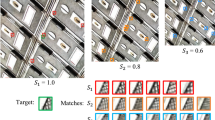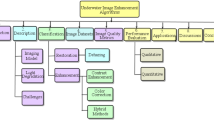Abstract
The non-uniform illumination in underwater causes degradation of images as when light propagates through water, it gets scattered and absorbed due to various factors. The captured underwater images are mainly suffer from color distortion, color cast, low contrast, poor illumination, and blurred details due to the optical properties of water. Underwater image enhancement plays a preprocessing stage for high-level vision tasks. Therefore, to restore the degraded image and for visual enhancement, we proposed a fusion method for an effective output. This method generates two versions of color-corrected input image and one is given for contrast limited adaptive brightness preservance histogram equalization(CLABPHE) and the other for uniform illuminated sharpened image. The two are fused using their weight maps: Luminance weight map, and Saliency detection weight map, and they are normalized and then multi-layered fused using Laplacian pyramid-based decomposition to get an enhanced output image. The quantitative and qualitative evaluation of the proposed method works effectively for several datasets. The qualitative evaluation shows our method is better than the other algorithms compared.












Similar content being viewed by others
Data Availability
No datasets were generated or analysed during the current study.
References
Ancuti CO, Ancuti C, De Vleeschouwer C et al (2017) Color balance and fusion for underwater image enhancement. IEEE Trans Image Process 27(1):379–393
Ancuti CO, Ancuti C, De Vleeschouwer C et al (2017) Color balance and fusion for underwater image enhancement. IEEE Trans Image Process 27(1):379–393
Buchsbaum G (1980) A spatial processor model for object colour perception. J Frankl inst 310(1):1–26
Cheng HD, Shi X (2004) A simple and effective histogram equalization approach to image enhancement. Digit Sig Process 14(2):158–170
Duntley SQ (1963) Light in the sea. JOSA 53(2):214–233
Ebner M (2021) Color constancy. In: Computer Vision: A Reference Guide. Springer, p 168–175
Finlayson GD, Trezzi E (2004) Shades of gray and colour constancy. In: Color and imaging conference, society for imaging science and technology, pp 37–41
Guo P, Zeng D, Tian Y et al (2020) Multi-scale enhancement fusion for underwater sea cucumber images based on human visual system modelling. Comput Electron Agric 175:105608
He K, Sun J, Tang X (2010) Single image haze removal using dark channel prior. IEEE Trans Pattern Anal Mach Intell 33(12):2341–2353
Ibrahim H, Kong NSP (2007) Brightness preserving dynamic histogram equalization for image contrast enhancement. IEEE Trans Consum Electron 53(4):1752–1758
Land EH (1977) The retinex theory of color vision. Sci Am 237(6):108–129
Li C, Guo C, Ren W et al (2019) An underwater image enhancement benchmark dataset and beyond. IEEE Trans Image Process 29:4376–4389
Li C, Anwar S, Porikli F (2020) Underwater scene prior inspired deep underwater image and video enhancement. Pattern Recogn 98:107038
Limare N, Lisani JL, Morel JM et al (2011) Simplest color balance. Image Processing On Line 1:297–315
Liu R, Fan X, Zhu M et al (2020) Real-world underwater enhancement: Challenges, benchmarks, and solutions under natural light. IEEE Trans Circ Syst Video Technol 30(12):4861–4875
Mittal A, Moorthy AK, Bovik AC (2012) No-reference image quality assessment in the spatial domain. IEEE Trans Image Process 21(12):4695–4708
Mittal A, Soundararajan R, Bovik AC (2012) Making a “completely blind" image quality analyzer. IEEE Signal Process Lett 20(3):209–212
Murino V, Trucco A (2000) Underwater computer vision and pattern recognition. Comput Vis Image Underst 79(1):1–3
Panetta K, Gao C, Agaian S (2015) Human-visual-system-inspired underwater image quality measures. IEEE J Ocean Eng 41(3):541–551
Reza AM (2004) Realization of the contrast limited adaptive histogram equalization (clahe) for real-time image enhancement. J VLSI Sig Process Syst Sig Image Vid Technol 38:35–44
Risholm P, Thielemann JT, Moore R et al (2018) A scatter removal technique to enhance underwater range-gated 3d and intensity images. In: OCEANS 2018 MTS/IEEE Charleston, IEEE, pp 1–6
Schechner YY, Karpel N (2005) Recovery of underwater visibility and structure by polarization analysis. IEEE Journal of oceanic engineering 30(3):570–587
Sethi R, Indu S (2020) Fusion of underwater image enhancement and restoration. Int J Pattern Recogn Artif Intell 34(03):2054007
Stark JA (2000) Adaptive image contrast enhancement using generalizations of histogram equalization. IEEE Trans Image Process 9(5):889–896
Van De Weijer J, Gevers T, Gijsenij A (2007) Edge-based color constancy. IEEE Trans Image Process 16(9):2207–2214
Wang S, Ma K, Yeganeh H et al (2015) A patch-structure representation method for quality assessment of contrast changed images. IEEE Signal Process Lett 22(12):2387–2390
Wang H, Zhao R, Cen Y et al (2018) Low-rank matrix recovery via smooth rank function and its application in image restoration. International Journal of Machine Learning and Cybernetics 9:1565–1576
Wang S, Chen Z, Wang H (2022) Multi-weight and multi-granularity fusion of underwater image enhancement. Earth Sci Inform 15(3):1647–1657
Yadav G, Maheshwari S, Agarwal A (2014) Contrast limited adaptive histogram equalization based enhancement for real time video system. In: 2014 international conference on advances in computing, communications and informatics (ICACCI), IEEE, pp 2392–2397
Yang M, Sowmya A (2015) An underwater color image quality evaluation metric. IEEE Trans Image Process 24(12):6062–6071
Zhang W, Wang Y, Li C (2022) Underwater image enhancement by attenuated color channel correction and detail preserved contrast enhancement. IEEE J Ocean Eng 47(3):718–735
Zhang W, Zhuang P, Sun HH et al (2022) Underwater image enhancement via minimal color loss and locally adaptive contrast enhancement. IEEE Trans Image Process 31:3997–4010
Zhang W, Zhou L, Zhuang P et al (2023) Underwater image enhancement via weighted wavelet visual perception fusion. IEEE Trans Circ Syst Video Technol
Acknowledgements
The authors gratefully acknowledge the Ministry of Minority Affairs(MoMA), Government of India for providing financial support through the Maulana Azad National Fellowship Scheme(MANF) to carry out this research work. The authors would also like to acknowledge Department of Science and Technology( DST) for rendering infrastructural support through the Fund for Improvement of S &T Infrastructure(FIST) project, Government of India and also the support provided by the Government Model Engineering College Ernakulam, Kerala, India and APJ AbdulKalam Technological University, Kerala, India for carrying out this work.
Funding
The presented work was supported by the Ministry of Minority Affairs(MoMA)- Maulana Azad National Fellowship (MANF)(no. F.82-87/2019 (SA III)), Government of India.
Author information
Authors and Affiliations
Contributions
All authors have contributed to the analysis studies and implementations. Hena Prince was involved in design, qualitative, and quantitative analysis and she also wrote the first draft of the manuscript.All authors including Binesh T commented on earlier versions of the manuscript and also approved the final manuscript.
Corresponding author
Ethics declarations
Conflict of Interest
There are no conflicts of interest to declare.
Ethics Approval
The study does not contain any elements with human participation/animals performed by any of the authors.
Competing interests
The authors declare no competing interests.
Additional information
Communicated by: H. Babaie.
Publisher's Note
Springer Nature remains neutral with regard to jurisdictional claims in published maps and institutional affiliations.
Rights and permissions
Springer Nature or its licensor (e.g. a society or other partner) holds exclusive rights to this article under a publishing agreement with the author(s) or other rightsholder(s); author self-archiving of the accepted manuscript version of this article is solely governed by the terms of such publishing agreement and applicable law.
About this article
Cite this article
Prince, H., T, B. An effective underwater image enhancement based on the fusion of CLAHE and image constancy sharpening technique. Earth Sci Inform 17, 1359–1372 (2024). https://doi.org/10.1007/s12145-024-01226-5
Received:
Accepted:
Published:
Issue Date:
DOI: https://doi.org/10.1007/s12145-024-01226-5




